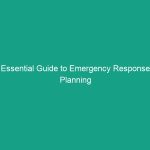Good Morning Team!
Welcome to today’s Toolbox Talk! Today, we’re diving into a crucial topic that affects every single one of us—Must-Know Guidelines for Achieving Zero Injuries in the Workplace. Safety is not just a priority; it is our responsibility. By focusing on these guidelines, we can create a safer work Environment for ourselves and our colleagues.
Understanding Must-Know Guidelines for Achieving Zero Injuries in the Workplace
So, what does it mean to achieve zero injuries in the workplace? Essentially, it involves implementing effective Safety protocols and fostering a culture of Safety where everyone actively participates. The importance of this concept cannot be understated—it impacts our daily operations, productivity, and overall well-being. A common misconception is that accidents are inevitable, but with the right measures, we can significantly reduce and even eliminate them.
Key Hazards, Risks, and Safety Considerations
Identifying specific Hazards and risks is the first step toward achieving our goal of zero injuries. Here are a few key hazards we must be aware of:
- Slips, Trips, and Falls: One of the most common workplace injuries. Wet floors, uneven surfaces, and clutter can lead to serious accidents.
- Manual Handling: Lifting heavy objects without proper technique can result in back injuries.
- Machinery Safety: Improper use or malfunctioning equipment can be dangerous.
- Ergonomic Risks: Poor workstation setup can lead to repetitive strain injuries.
Ignoring safety protocols can lead to real-world consequences, including injuries, lost productivity, and even legal repercussions for the company. We must remain vigilant and proactive in addressing these hazards.
Best Practices, Procedures, & Actionable Advice
Now that we’ve identified the hazards, let’s discuss some Best Practices to ensure our safety:
1. Conduct Regular Safety Training
Continuous education is key. Ensure you participate in all safety training sessions and refreshers offered. These sessions are designed to keep you informed about the latest safety Procedures.
2. Use Personal Protective Equipment (PPE)
Always wear the appropriate PPE for your tasks. This includes hard hats, gloves, safety glasses, and steel-toed boots. Remember, PPE is your last line of defense against workplace hazards.
3. Maintain Clean Work Areas
A tidy workspace reduces the risk of accidents. Make sure to keep aisles clear and promptly clean up any spills.
4. Follow Proper Lifting Techniques
When lifting heavy items, use your legs for power, keep your back straight, and avoid twisting. If the load is too heavy or awkward, ask for help.
5. Report Hazards Immediately
If you notice any unsafe conditions, report them to your supervisor right away. Early intervention can prevent accidents from occurring.
Case Study: Real-World Example
Consider the case of a manufacturing plant where an employee ignored the proper lockout/tagout procedures. This lapse led to a severe injury when the machinery unexpectedly started. This incident not only affected the injured employee but also caused downtime and lost productivity for the entire team. Let’s learn from this example: always follow safety protocols!
Regulations, Standards, and Compliance
It’s essential to be aware of the Regulations that govern Workplace Safety. Compliance with Standards set by organizations such as OSHA (Occupational Safety and Health Administration) is non-negotiable. These regulations are in place to protect us, and adherence to them is critical in maintaining a safe working environment.
Employee Engagement & Discussion
Now, let’s open the floor for discussion. What safety challenges have you encountered related to achieving zero injuries? Sharing our experiences can help us learn from one another and improve our safety practices.
Conclusion & Key Takeaways
In conclusion, achieving zero injuries in the workplace is a shared responsibility that requires our collective effort. By understanding the hazards, following Best Practices, and engaging in open discussions about safety, we can foster a culture of safety that protects everyone. Remember, safety isn’t just a requirement; it’s a commitment we make to each other.
Thank you all for your attention and dedication to maintaining a safe workplace. Let’s continue to prioritize safety every single day!


